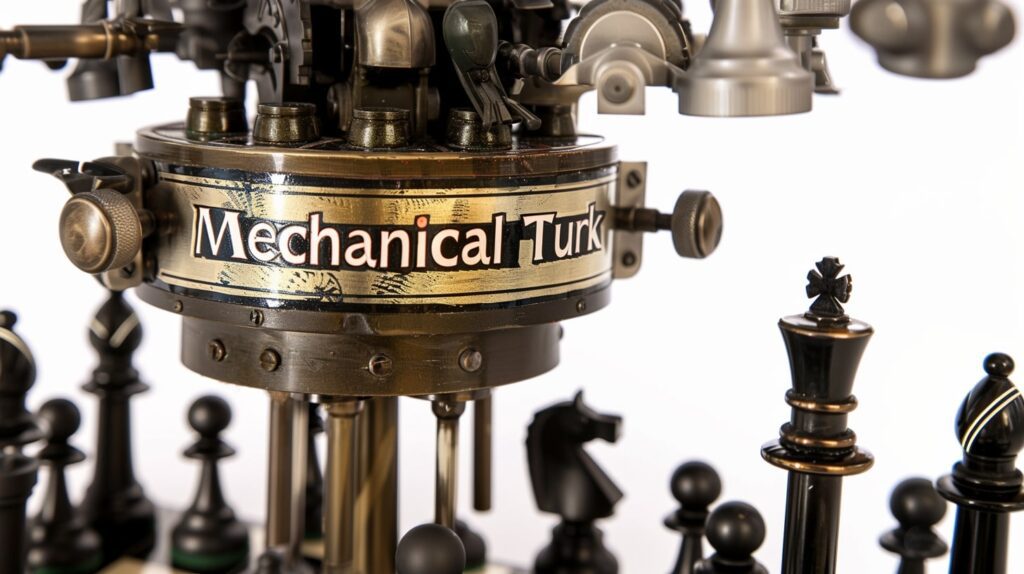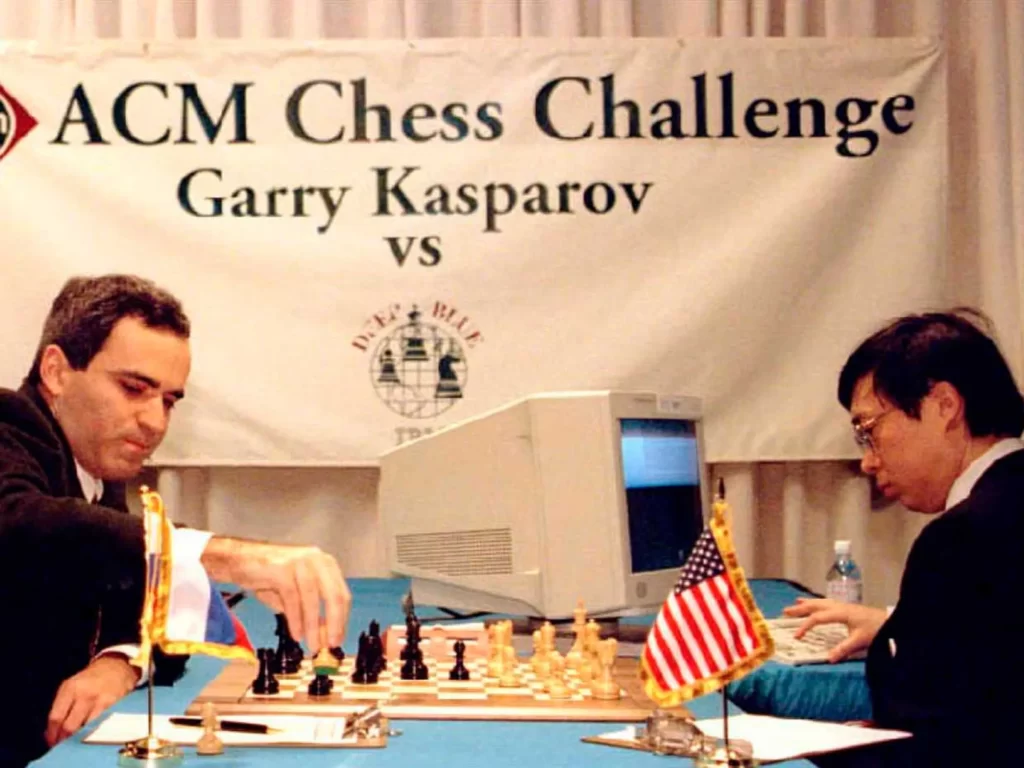
The world of chess has long been a stage for brilliant displays of human strategy and calculation. However, the ever-growing power of artificial intelligence (AI) has revolutionized the game. The clashes between human grandmasters and powerful chess engines have produced captivating narratives of triumph and defeat, leading to incredible advancements in both human and computer chess play. Let’s delve deeper into the most memorable of these encounters:
Early Chess Computers: Setting the Stage
The dream of a chess-playing machine is an ancient one, stretching back centuries. The 18th-century saw the rise of the “Mechanical Turk,” a chess-playing automaton unveiled by Wolfgang von Kempelen in 1770. This incredible machine toured Europe, defeating prominent figures such as Benjamin Franklin and Napoleon Bonaparte. Although later revealed to be an elaborate hoax concealing a human chess player, the Mechanical Turk fueled the idea that a true, calculating chess machine was within reach.
While genuine artificial chess players remained elusive, the foundations for their eventual development were laid in the early 20th century. In 1912, Leonardo Torres y Quevedo built “El Ajedrecista”– a machine capable of playing a simplified endgame of king and rook versus king. More importantly, El Ajedrecista was a true automaton, making decisions without human intervention.
The birth of modern computers ushered in a new era of chess machine development. Alan Turing, a pioneering figure in computer science, conceptualized a chess-playing computer program in 1950. The following years saw the development of rudimentary programs capable of playing a simplified version of the game. A significant milestone was achieved with the creation of “Mac Hack VI” in 1967 by Richard Greenblatt and others at MIT. This program became the first to compete against humans in chess tournaments. While its play was still primitive, programs like Mac Hack VI proved that computers could master the basic mechanics of chess, opening the door for the rapid advancements that were to come.
Deep Blue vs. Garry Kasparov (1996-1997): A Seismic Shift
Garry Kasparov was widely considered the greatest chess player of all time, his aggressive style and deep strategic insight making him a near-mythical figure in the game. IBM’s supercomputer, Deep Blue, was a technological marvel, capable of evaluating 200 million chess positions per second. The 1996 match between the two was seen as a symbolic battle between human intuition and brute-force computing power

The match
In 1996, Deep Blue won a single game in the six-game match, a historic first for a computer against a reigning world champion under tournament conditions. While Kasparov ultimately prevailed 4-2, the machine’s victory sent shockwaves through the chess world.
The 1997 rematch was a highly publicized event. Deep Blue had been significantly upgraded, and Kasparov faced mounting psychological pressure. The final, decisive game was a shockingly short affair. Choosing a risky variation of the Caro-Kann Defense, Kasparov hoped to unbalance the powerful chess engine. However, Deep Blue countered with an unexpected knight sacrifice, quickly seizing the initiative and dismantling Kasparov’s defenses. Kasparov’s position rapidly deteriorated, forcing him to resign after a mere 19 moves. The abrupt end to such a high-stakes match sent shockwaves through the chess world. Kasparov, shaken by the defeat, accused IBM of cheating, sparking a debate about the role of human intervention in computer chess that continues to this day.
Aftermath
Kasparov’s defeat shook the chess community, sparking a debate about whether machines could truly become smarter than humans. This match fundamentally shifted public perception of AI, accelerating research into its potential within chess and beyond.
- A Symbolic Shift: Deep Blue’s victory was far more than just a chess result. It was a watershed moment, symbolizing the potential of artificial intelligence to surpass humans in what was considered a domain of pure intellectual power.
- The Debate Rages: The match sparked intense discussion about machine intelligence and its future implications. Kasparov’s accusations of cheating, while unsubstantiated, fueled concerns about fairness in human vs. AI competitions and the potential for human intervention.
- Rapid Advancement: Deep Blue’s win spurred remarkable development in chess engines. Programs became stronger, faster, and more sophisticated, fundamentally changing how chess players prepare and analyze their games.
- Hybrid Approach: While a major blow to human chess dominance, Kasparov later embraced the concept of collaborative chess. He pioneered “advanced chess”, where humans utilize chess engines strategically for training and preparation, leading to a hybrid style that pushes the boundaries of the game.
Vladimir Kramnik vs. Deep Fritz (2006): Refinement and Resilience
Kramnik’s match against Deep Fritz is remembered as much for its controversy as for the computer’s victory. The match itself was fraught with tension, with Kramnik initially refusing to play game five in protest due to accusations surrounding his opponent’s bathroom visits. While the match eventually continued, a shocking blunder saw Kramnik forfeit game two after just one move, leaving the chess world stunned.
The match
In game two of his match against Deep Fritz, Vladimir Kramnik was presented with a complex position where a slight advantage might have been achievable for the engine. However, a moment of inexplicable carelessness led to him playing 34…Qe3??, instantly collapsing his position. Kramnik overlooked the devastating reply 35.Nxf7!, forcing a beautiful mate in one: 35…Kxf7 36. Qh7#.
Stunned commentators and analysts struggled to comprehend how a grandmaster of Kramnik’s caliber could fail to see such a simple and deadly tactic.
Aftermath
Kramnik himself attributed the blunder to fatigue and the immense psychological pressure of the match. Kasparov, always the analyst, theorized that a software bug may have influenced the engine to deviate from its typical line, leading to Kramnik overlooking the deadly tactic.
While the exact reason for the blunder remains elusive, this moment stands as a stark reminder of the fallibility of even the greatest human minds under the relentless pressure of facing a tireless machine opponent.
Other noticeable confrontations
The world of chess has been a stage for many captivating battles between human intellect and the ever-evolving power of chess engines. Here are a few more matches that highlight milestones and memorable moments in this ongoing clash:
Kasparov vs. X3D Fritz (2003)
A unique exhibition match found Kasparov battling a 3D-visualization of the Fritz chess engine. Despite playing in an unfamiliar format and granted overnight adjournments, the match ended as a 2-2 draw, highlighting the incredible level machines had reached.
Veselin Topalov vs. Rybka (2008)
Topalov’s defeat to the Rybka engine was clouded by his team’s accusations of cheating. They alleged that Rybka’s moves were uncannily similar to those suggested by other chess engines, raising concerns about fair play in human vs. machine contests.
Hikaru Nakamura vs. Stockfish (2023 and onward)
Nakamura, an American grandmaster and top speed chess player, has become a popular figure in online battles against powerful engines like Stockfish. These fast-paced encounters emphasize human intuition and creativity as a counterpoint to the machine’s brute-force calculation, attracting huge online audiences in the process.
The Future of Human vs. Machine Chess
The ongoing battle between humans and chess engines raises fascinating questions about the limits of human intelligence and the potential of machines. While AIs have undeniably surpassed humans in terms of raw calculating power, human creativity, intuition, and adaptability remain valuable assets in modern chess. Rather than a competition for dominance, the relationship between humans and chess computers has evolved into a collaboration. Top players often train with chess engines, using them to analyze positions, refine their openings, and discover new strategies. This hybrid approach pushes the boundaries of chess knowledge and leads to ever more exciting and innovative play.
Chessiverse: Where Humans and AI Strategists Meet
The history of human vs. chess machine rivalry is a tale of relentless innovation and adaptation. In recent years, a new wave of chess AI projects has emerged, focused on building chess bots that exhibit more human-like playing styles. Chessiverse stands at the forefront of this movement.
Based on cutting-edge neural networks like Maia and the open-source Leela Chess Zero (LC0), Chessiverse’s bots offer a unique experience for players of all levels. Unlike traditional chess engines that prioritize brute-force calculation, these bots learn and evolve. They are less focused on perfect play and instead develop distinctive styles, strengths, and even weaknesses.
By battling bots within Chessiverse, players can encounter a wider variety of challenges, forcing them to think creatively and break free from rigid patterns. This hybrid approach, blending human ingenuity with the innovative potential of AI, paves the way towards an even more exciting and dynamic future for the game of chess.
